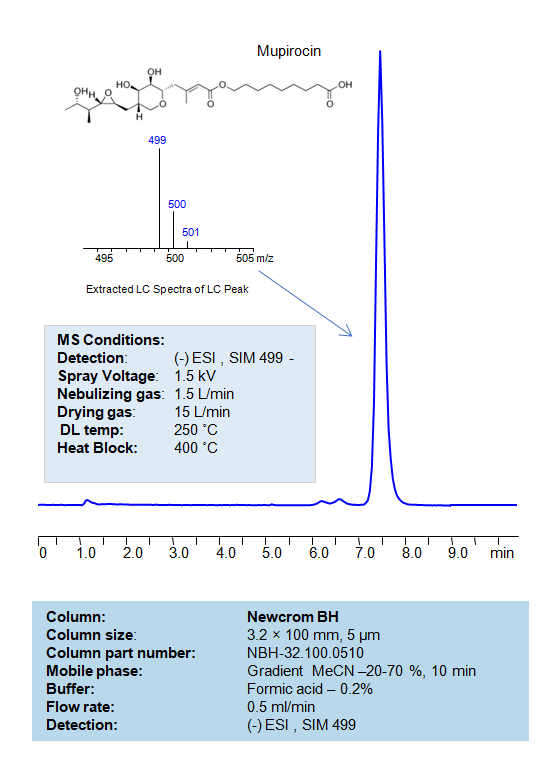HPLC Method for Analysis of Mupirocin on Newcrom BH Column by SIELC Technologies
Separation type: Liquid Chromatography Mixed-mode
Mupirocin is an antibiotic ointment commonly used for the treatment of bacterial skin infections.
Mechanism of Action: Mupirocin works by inhibiting the bacterial enzyme isoleucyl-tRNA synthetase. This disruption prevents the bacteria from making necessary proteins, leading to its death.
Usage:
Topical Mupirocin: Commonly prescribed for skin infections caused by Staphylococcus and Streptococcus bacteria. It is effective against both methicillin-sensitive Staphylococcus aureus (MSSA) and methicillin-resistant Staphylococcus aureus (MRSA).
It is also used to eliminate nasal colonization of MRSA in some healthcare settings.
Formulation: Mupirocin is typically available as a topical ointment or cream. There is also a nasal formulation for specific uses.
Mupirocin can be retained, separated, and analyzed on a mixed-mode Newcrom BH column with a mobile phase consisting of water, Acetonitrile (MeCN), and Ammonium Formate. This analytical method can be detected with high resolution and peak symmetry with many evaporative detection methods, including Evaporative Light Scattering Detection (ELSD), Charged Aerosol Detector (CAD), and Electrospray Ionization (ESI) for Mass Spectrometry (MS).
High Performance Liquid Chromatography (HPLC) Method for Analyses of Michler’s ketone
Condition
| Column | Newcrom BH, 3.2 x 100 mm, 5 µm, 100 A, dual ended |
| Mobile Phase | Gradient MeCN – 20-70%, 10 min |
| Buffer | Formic acid – 0.2% |
| Flow Rate | 0.5 ml/min |
| Peak Retention Time | 7.58 min |
| Detection | (-) ESI , SIM 499 – |
| Spray Voltage: | 1.5 kV |
| Nebulizing gas: | 1.5 L/min |
| Drying gas: | 15 L/min |
| DL temp: | 250 ˚C |
| Heat Block: | 400 ˚C |
Description
| Class of Compounds | Drug, antibiotic |
| Analyzing Compounds | Mupirocin |
Application Column
Newcrom BH
Column Diameter: 3.2 mm
Column Length: 100 mm
Particle Size: 5 µm
Pore Size: 100 A
Column options: dual ended






